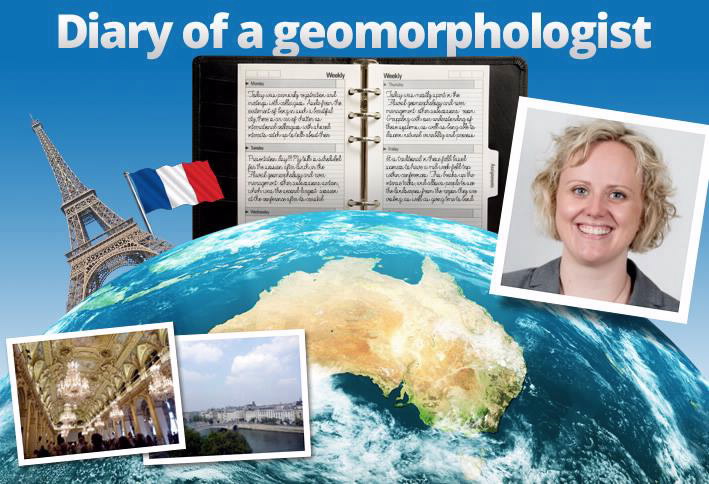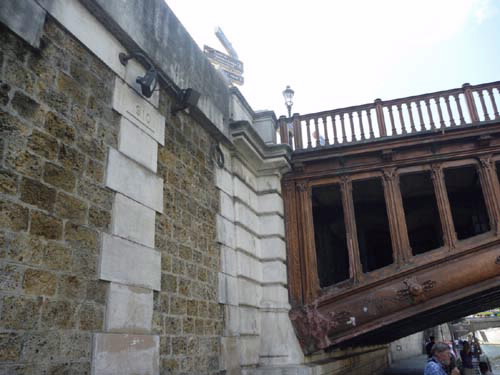It's often argued that we have a better understanding of the surface of the Moon or Mars than we do of the Earth's ocean floor. In fact, present estimates suggest perhaps less than 2 per cent of the sea floor is known at high resolution.
 |
That will change if geomorphologists, like Stephanie Kermode have something to say about it. Kermode is an environmental scientist who is part of ANSTO's graduate program. She recently attended the 8th IAG International Conference on Geomorphology held in Paris at the Cité des Sciences de La Villette.
Geomorphology is the study of landscape processes, and literally means “earth shape”. This field is becoming increasingly important in helping to minimise impacts of natural events on communities.
The main topic for this conference was "Geomorphology and Sustainability". Kermode reports on the outcomes of the conference that boasted over 1400 attendees, 26 scientific sessions and 5 keynote lectures, and also gave her an opportunity to present her research.
Day 1
Today was primarily registration and meetings with colleagues. Aside from the excitement of being in such a beautiful city, there is an air of chatter as international colleagues with shared interests catch up to talk about their work. There is a strong showing from Australian institutions, which reflects the strength of the Australian geomorphic community on the international stage, including members of the Australian and New Zealand Geomorphology Group of which I’m the Australian Representative.
After some preliminaries, we are able to upload our talks in the media centre, and get a hard copy of the program. Deciding which of the parallel sessions to attend at any given time was a difficult task! Thanks to our colleagues from Groupe Français de Géomorphologie (GFG) for organising such a wonderful event.
Day 2
Presentation day!!!! My talk is scheduled for the session after lunch, in the Fluvial geomorphology and river management: other subsessions section, which was the second largest ‘session’ at the conference after its coastal counterpart. I am talking about the implications of my work on the Shoalhaven River on current in-channel bench theory, which highlights areas where current models don’t explain the depositional features recorded across several sites.
I believe that the notion of recurrence intervals needs to be re-examined, and that the complexity of erosion and deposition need to be more fully engaged with. The timing of Tuesday afternoon is great because it means I get the remainder of the week to discuss it with both existing and newly met colleagues. A lively bench-theory discussion over breakfast was the perfect ‘warm-up’ to the later presentation and ensuing discussion of my work.
Today was the only day with two key-note lectures, the first being “Tales from the Deep” from Prof Denys Brundsen of Kings College, London, regarding the vast areas of submarine geomorphology which remain unstudied and that conceptually, these processes lag behind our sub-aerial understanding.
The latter of these was “Geomorphology of Earth-Like Planetary Surfaces” by Victor Baker of the University of Arizona. It covered our current understanding of surface processes on other planets and provided an overview of how this has shaped our understanding of those here on earth, and how further studies could help us answer remaining questions. Although the day was shorter than others (0930-1800 hours), everyone was glad to head over to our evening welcome event.
The day culminates in an official welcome from the Mayor of Paris at Hôtel de Ville (Paris City Hall, Picture 1). And yes, they did serve cheeses with Bordeaux and Champagne.
 |
| Picture 1: The reception hall at Hôtel de Ville where delegates were officially welcomed to Paris by the Mayor. |
Day 3
Today was mostly spent in the ‘Fluvial geomorphology and river management: other subsessions’ room. Grappling with our understanding of these systems, as well as being able to discern natural variability and process form anthropogenic influence was a topic which wove through many of the talks, and is really important for us to consider as we try to understand these naturally dynamic systems. The session convenors, Janet Hooke and Gary Brierley should be congratulated for composing a great session.
Of particular note for me was beginning to develop my understanding of the EU Water Framework Directive, which to date I’ve had little to do with. Particularly in the UK, recent large flooding have really emphasised the significance of understanding river systems due to the impacts of these systems on humans and infrastructure. There is some great work appearing (and being presented here) on understanding historical changes, geomorphic impact of large events and suitable management strategies.
I did, however, skip out on part of the day in order to attend the ‘Dating methods’ subsection of ‘Methods in Geomorphology’, as geochronology is a key interest of mine. These talks showed the application of methods such as cosmogenic, luminescence, radiocarbon and dendrochornological techniques alongside the use of appropriate historical archives. As I look forward to learning about cosmogenic dating next year at ANSTO, it was good to see some current ‘outside’ work.
In the evening, the Australian and New Zealand Geomorphology Group held a dinner, organised by President, Jacky Croke of Griffith University/ Australian Rivers Institute. It was a well-attended and enjoyable evening of traditional French cuisine (of course including snails) in the Centre of Paris, as well as a nice opportunity to reconnect with our ‘local’ network of geomorphologists.
Day 4
It is traditional in these field based sciences to have a mid-week field trip within conferences. This breaks up the intense talks, and allows people to see the landscapes from the region they are visiting, as well as giving time to bond with fellow colleagues.
I signed up for “The Great 1910 Flood in Paris”. We started with some talks, showing the flood mapping that has been recreated for the event, as well as historical photographs, and challenges that flooding created in this time. We were lucky enough to also hear about the modern flood strategies and even see those that are planned to be built over the coming years!
The foot print of the 1910 flood was certainly small compared with recent events in Australia (notably the Queensland floods in 2010 and 2011). However, the valuable historical and cultural assets in Paris, such as all those paintings in the Louvre and Musee D’Orsee mean that overtopping has huge implications and that strategies to protect these assets need to be adequate and in place.
In short, the reason that the flood overtopped the banks of the Seine in the city centre was largely because the tributaries in the area had flood peaks occur simultaneously, as well as being statistically rare events (large floods). The strategy today therefore focuses on being able to stagger the water entering the main channel to keep the peak small enough to be retained by the banks.
Picture 2 shows the view from the roof of the Institut du Monde Arabe where we discussed the flood. After this we walked along the river looking at flood markers along the banks, and out into the city (Pictures 3 and 4). Picture 3 shows a flood marker along the bank of the Seine, and Picture 4 , near the base of the building, you will see a green tile with “CRUE” written, and the Janier 1910.
 |
| Picture 2: View of the Seine, from the roof of the Institut du Monde Arabe, including the rear of Notre Dame Cathedral. |
 |
| Picture 3: Flood level marker of the Great Flood of 1910 from inside the protective banks of the Seine. |
 |
| Picture 4: The green tile at the bottom of the wall is a marker of the 1910 Great Flood, this street is ~100 metres from the channel. |
Day 5
The final block of ‘Fluvial geomorphology and river management; other subsessions’ talks were on Friday morning. It was the best session of the week, and included the best talk of the conference (in my opinion). It was a very practical session which focused on actual management strategies, past failures, successes, progress in and current restoration strategies.
The presentation of Ian Rutherford (University of Melbourne) entitled ‘Making space for geomorphic processes: the example of buffers for rivers’ was a hit, and touched on the frustrations felt by most geomorphologists involved in the planning industry that effectively, the legislation and political will for effective planning are not in synch with the science. This led to his suggestion that IAG form a working group on rivers and planning, which was well received and looks to make some important contributions over the coming years.
The remainder of the day I spent split between talks in sessions of ‘Sediment fluxes and morphodynamics of streams’ and ‘Human impacts on landscapes’. Understanding the nature of sediment flux in streams is critical to understanding the processes occurring, and from a theoretical stand point through to designing restoration or management measures (even if the plan is essentially to leave it be).
Human impacts are increasingly important not only to theoretical understanding of systems, since so few are unimpacted, but also for practical applications as these impacts are occurring alongside natural variability of the systems and responses to other external measures such as climate change, tectonics and so forth.
Day 6
The final day. While everyone is tired at this stage, there is also a tinge of sadness that the event is coming to a close. Today, for me, was the most difficult day to pick talks or sessions to attend as there were so many things not only of interest but of direct relevance to my work.
One very interesting session was focused on the issues of magnitude versus frequency. This debate is on-going in geomorphology and ponders how the role of small but frequent events compares to infrequent extreme magnitude events. The daily flow of water might grind away at rock over millennia to make stunning gorges and canyons, but a single cyclone can also perform landscape changing work.
One of these talks, by Veerle Vanacker based in Belgium also examined the role of human activity in changing the balance of the impacts of these different types of events. It was stated that the tropics are most strongly affected in terms of changes in vegetation type and cover. It is well recognised that tropical landscapes are susceptible to erosion, partly due to the heat speeding up chemical weathering processes, but the abundance of rain also aids physical weathering by removing of sediments and other material.
The highlight talk of the day, for me, was by Geoff Vietz of the University of Melbourne. Entitled “Stream geomorphology is drastically altered by small amounts of urbanisation”, it was clear what the content would discuss and it did not disappoint! But the very valuable part was the implications of this, which fit nicely with concepts presented in Friday morning session and the new IAG working group focus.
In the after-lunch session I was able to attend the last of the FLAG (Fluvial Archives Group), GLOCOPH (Global Continental Palaeohydrology Hydrology), a session I would have like to heard more of, other things permitting. The day then concluded with the final key note talk (Prof. Xiaoping Yang of the Institute of Geology and Geophysics, China, “Geomorphology and palaeoenvironmental changes in arid Asia), the IAG General Assembly and closing session. The 9th International Conference on Geomorphology will be held in 2017, hosted in Calcutta, India. The proposed dates were altered to avoid the monsoon season.
Published: 12/11/2013


